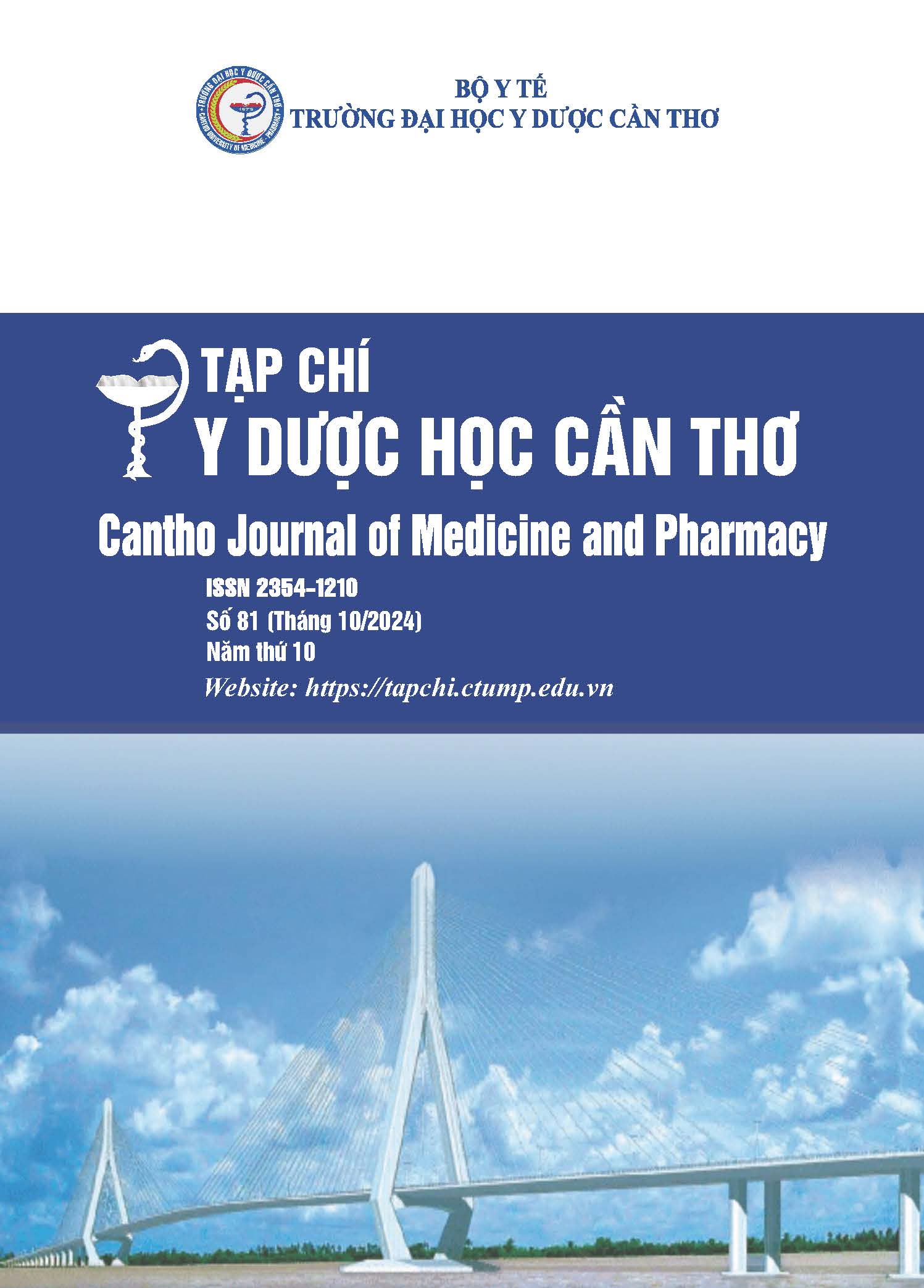THE EXPRESSION OF p16, p53, pRb PROTEINS IN TUMOR BIOPSY TISSUE BY IMMUNOHISTOCHEMISTRY IN THE OROPHARYNGEAL SQUAMOUS CELL CARCINOMA PATIENTS
Main Article Content
Abstract
Background: The expression of HR-HPV indicators, proteins p16, p53, and pRb in tumor biopsy tissue plays a significant role in the diagnosis and prognostication of patients with oropharyngeal cancer. Objectives: To examine the expression of the proteins p16, p53, and pRb in oropharyngeal tumor biopsy tissue, as well as the correlation between the frequency of p16, p53, pRb, and HR-HPV infection in oropharyngeal squamous cell carcinoma (OPSCC). Materials and methods: An overview of 30 patients diagnosed with oropharyngeal squamous cell carcinoma who were admitted to Can Tho Oncology Hospital between January 2023 and July 2023 using a cross-sectional approach. Employing Real-time PCR methods to look at the expression of HR-HPV kinds in malignant biopsy tissue that has been fixed with formalin and placed in paraffin candles, as well as immunohistochemistry methods to look at the expression of p16, p53, and pRb proteins. Results: The patients' ages ranged from 58.73 +/- 9.37 years on average. The ratio of men to women is 9 to 1. In biopsy tissue, the rate of HR-HPV infection was 56.7%, with 100% of cases being type HPV16. The percentages of p16(+) and p16 (-) were 26.7% (8/30) and 73.3% (22/30); p53 (+) and p53 (-) were 30% (9/30) and 70% (21/30); pRb (+) and pRb (-) are 53.3% (16/30) and 46.7% (14/30). There is an inverse association between the expression of HR-HPV and the expression of p53 and pRb in tumor biopsy tissue, but p > 0.05. No association between p16 expression and HR-HPV in tumor biopsy tissue. Conclusion: In tumor biopsy tissue from patients with oropharyngeal cancer, the expression of HR-HPV indicators is quite high and inversely correlated with the expression of p53 and pRb.
Article Details
Keywords
OPSCC, high-risk HPV type, p16, p53, pRb
References
2. Plath M, Broglie MA, Förbs D, et al. Prognostic significance of cell cycle-associated proteins p16, pRB, cyclin D1 and p53 in resected oropharyngeal carcinoma. Journal of otolaryngology - head & neck surgery. 2018. 47(1), 53, doi: 10.1186/s40463-018-0298-3.
3. Benzerdjeb N, Tantot J, Blanchet C, et al. Oropharyngeal squamous cell carcinoma: p16/p53 immunohistochemistry as a strong predictor of HPV tumour status. Histopathology. 2021. 79(3), 381-390, doi: 10.1111/his.14350.
4. Jiromaru R, Yamamoto H, Yasumatsu R, et al. p16 overexpression and Rb loss correlate with high-risk HPV infection in oropharyngeal squamous cell carcinoma. Histopathology. 2021. 79(3), 358-369, doi: 10.1111/his.14337.
5. Ndon S, Singh A, Ha PK, et al. Human Papillomavirus-Associated Oropharyngeal Cancer: Global Epidemiology and Public Policy Implications. Cancers. 2023. 15(16), 4080, doi: 10.3390/cancers15164080.
6. Shaikh MH, McMillan NA, Johnson NW R, et al. HPV-associated head and neck cancers in the Asia Pacific: A critical literature review & meta-analysis. Cancer epidemiology. 2015. 39(6), 923-38, doi: 10.1016/j.canep.2015.09.013.
7. Smith EM, Rubenstein LM, Henry H, et al. Human papillomavirus, p16 and p53 expression associated with survival of head and neck cancer. Infectious agents and cancer. 2010. 5(4), doi: 10.1186/1750-9378-5-4.
8. Shinohara S, Kikuchi M, Tona R, et al. Prognostic impact of p16 and p53 expression in oropharyngeal squamous cell carcinomas. Japanese journal of clinical oncology. 2014. 44(3), 232-40, doi: 10.1093/jjco/hyt223.
9. Machczyński P, Majchrzak E, Niewinski PR, et al. A review of the 8th edition of the AJCC staging system for oropharyngeal cancer according to HPV status. Eur Arch Otorhinolaryngol. 2020. 277(9), 2407-2412, doi: 10.1007/s00405-020-05979-9.
10. Weinberger PM, Yu Z, Haffty BG R, et al. Molecular classification identifies a subset of human papillomavirus associated oropharyngeal cancers with favorable prognosis. J Clin Oncol. 2006. 24(5), 736-47, doi: 10.1200/JCO.2004.00.3335.


